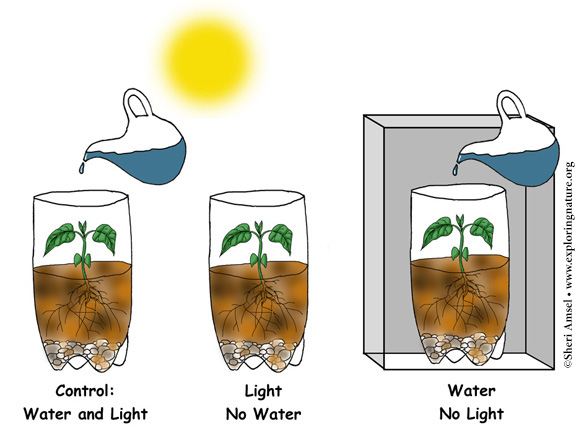

Essential Questions:
1. Why does one organism of the same species look different from another?
2. How can an organism’s characteristics be affected by their environment?
Goals: Students are going to use evidence to support the explanation that traits can be influenced by the environment.
Materials:
Procedures:
Students will take three plants that are about the same size and expose them to different environmental factors to see if they grow the same way. You start 3-5 planters in case not all seeds grow. You only need three for the experiment.
1. Cover the bottom of each planter with small rocks and add 6-8 inches of potting soil.
2. Plant one seed in each planter and water them the same amount.
3. Expose them to the same warm temperature and sunlight. When the plants are about 6 inches tall and have several leaves, the experiment can begin.
4. Keep two of the planters in the sunlight and place one under a box (or in a dark closet or drawer so it gets no sunlight).
5. Label Plant 1 – the control plant receiving water and sunlight.
Label Plant 2 – the plant that gets sunlight, but no water.
Label Plant 3 – The plant that gets watered every day, but receives no sunlight.
6. Note the differences in the plants after 3 days, 6 days, 9 days, and 12 days.
Observation and Discussion: Can you see any differences between the plants? Are the differences inherited from their parent plants or affected by their environment - sunlight, temperature, water? Is this the result you expected?
Grade 3 - 3-LS3 Heredity: Inheritance and Variation of Traits
NGSS Disciplinary Core Ideas
LS3.A: Inheritance of Traits
• Many characteristics of organisms are inherited from their parents. (3-LS3-1)
• Other characteristics result from individuals’ interactions with the environment, which can range from diet to learning. Many characteristics involve both inheritance and environment. (3-LS3-2)
LS3.B: Variation of Traits
• Different organisms vary in how they look and function because they have different inherited information. (3-LS3-1)
• The environment also affects the traits that an organism develops. (3-LS3-2)
Performance Expectations Students who demonstrate understanding can:
3-LS4-2. Use evidence to construct an explanation for how the variations in characteristics among individuals of the same species may provide advantages in surviving, finding mates, and reproducing. [Clarification Statement: Examples of cause and effect relationships could be plants that have larger thorns than other plants may be less likely to be eaten by predators; and, animals that have better camouflage coloration than other animals may be more likely to survive and therefore more likely to leave offspring.]
3-LS4-3. Construct an argument with evidence that in a particular habitat some organisms can survive well, some survive less well, and some cannot survive at all. [Clarification Statement: Examples of evidence could include needs and characteristics of the organisms and habitats involved. The organisms and their habitat make up a system in which the parts depend on each other.]
When you research information you must cite the reference. Citing for websites is different from citing from books, magazines and periodicals. The style of citing shown here is from the MLA Style Citations (Modern Language Association).
When citing a WEBSITE the general format is as follows.
Author Last Name, First Name(s). "Title: Subtitle of Part of Web Page, if appropriate." Title: Subtitle: Section of Page if appropriate. Sponsoring/Publishing Agency, If Given. Additional significant descriptive information. Date of Electronic Publication or other Date, such as Last Updated. Day Month Year of access < URL >.
Amsel, Sheri. "Variation of Traits - Plant Investigation" Exploring Nature Educational Resource ©2005-2024. December 13, 2024
< http://www.exploringnature.org/db/view/Variation-of-Traits-Plant-Investigation >
